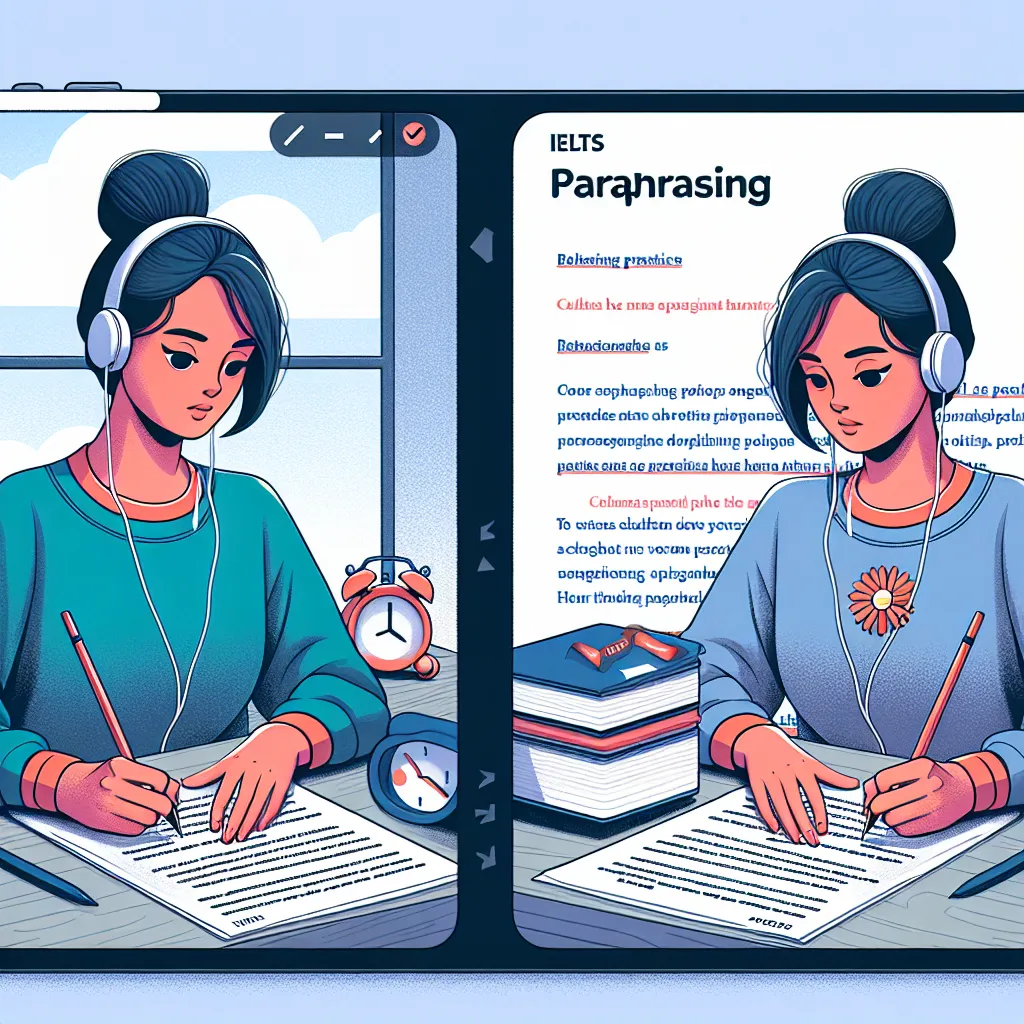Paraphrasing is a crucial skill in the IELTS exam, playing a significant role in demonstrating your language proficiency and understanding of English. This article will explore the importance of paraphrasing in IELTS, how it’s assessed, and provide practical tips to improve your paraphrasing skills.
Understanding Paraphrasing in IELTS
Paraphrasing is the ability to express the same idea using different words and sentence structures. In the context of IELTS, it’s a fundamental skill that’s evaluated across all sections of the test: Listening, Reading, Writing, and Speaking.
 Paraphrasing in IELTS
Paraphrasing in IELTS
Why is Paraphrasing Important in IELTS?
-
Demonstrates language flexibility: Paraphrasing showcases your ability to use a wide range of vocabulary and grammatical structures.
-
Avoids plagiarism: In the Writing and Speaking sections, paraphrasing helps you incorporate ideas from the question or prompt without copying them word-for-word.
-
Shows comprehension: Effective paraphrasing indicates that you understand the material well enough to express it in your own words.
-
Improves band scores: Skilled paraphrasing can positively impact your scores across all IELTS components.
Paraphrasing in Different IELTS Sections
Paraphrasing in IELTS Listening
In the Listening test, paraphrasing is often used in questions. You need to recognize synonyms and rephrased ideas to match the audio content with the questions.
Example:
Audio: “The conference will commence at 9 AM sharp.”
Question: “What time does the meeting begin?”
Paraphrasing in IELTS Reading
The Reading section frequently uses paraphrasing in both questions and answer choices. You must identify ideas expressed differently from the original text.
Example:
Text: “The government has implemented stringent measures to curb pollution.”
Question: “What has the administration done to address environmental concerns?”
Paraphrasing in IELTS Writing
Paraphrasing is crucial in both Task 1 and Task 2 of the Writing section.
In Task 1, you need to paraphrase the question statement in your introduction.
Original: “The graph shows the number of international students in different countries.”
Paraphrase: “The chart illustrates the distribution of foreign learners across various nations.”
In Task 2, paraphrasing helps you restate the essay question and incorporate ideas from the prompt without copying.
Paraphrasing in IELTS Speaking
During the Speaking test, paraphrasing allows you to clarify your points, explain concepts in different ways, and show your vocabulary range.
Example:
Question: “What do you think about public transportation in your city?”
Paraphrased response: “Regarding the communal transit system in my urban area, I believe…”
Techniques for Effective Paraphrasing
-
Use synonyms: Replace words with similar meanings.
Original: “The movie was excellent.”
Paraphrase: “The film was outstanding.” -
Change word forms: Alter nouns to verbs, adjectives to adverbs, etc.
Original: “There was a significant increase in sales.”
Paraphrase: “Sales increased significantly.” -
Restructure sentences: Modify the sentence structure while maintaining the meaning.
Original: “Despite the rain, they enjoyed the picnic.”
Paraphrase: “They had a good time at the picnic, although it was raining.” -
Use active/passive voice: Switch between active and passive constructions.
Original: “The committee approved the proposal.”
Paraphrase: “The proposal was approved by the committee.” -
Break down or combine sentences: Split complex sentences or merge simple ones.
Original: “He was tired. He went to bed early.”
Paraphrase: “Feeling exhausted, he decided to retire for the night earlier than usual.”
Common Mistakes to Avoid
-
Changing meaning: Ensure your paraphrase retains the original idea.
-
Using too similar language: Avoid merely swapping a few words; aim for a more comprehensive rephrasing.
-
Overcomplicating: Keep your paraphrase clear and concise.
-
Forgetting context: Ensure your paraphrase fits the context of the question or passage.
Practicing Paraphrasing for IELTS
-
Read extensively: Exposure to various writing styles enhances your paraphrasing abilities.
-
Use paraphrasing tools wisely: Online tools can provide ideas, but don’t rely on them entirely.
-
Practice regularly: Incorporate paraphrasing exercises into your daily IELTS preparation routine.
-
Seek feedback: Have a teacher or study partner review your paraphrasing attempts.
-
Time yourself: Practice paraphrasing under timed conditions to prepare for the actual test.
 IELTS Paraphrasing Practice
IELTS Paraphrasing Practice
Conclusion
Paraphrasing is an essential skill in IELTS, influencing your performance across all test sections. By understanding its importance and practicing regularly, you can improve your ability to express ideas flexibly and accurately. Remember, effective paraphrasing not only helps in achieving a higher IELTS score but also enhances your overall English language proficiency.
[internal_links]
- IELTS Writing Task 1: A Step-by-Step Guide
- Top 10 IELTS Speaking Strategies
- How to Improve Your IELTS Reading Speed and Accuracy
- IELTS Listening: Tips for Each Question Type
[/internal_links]




